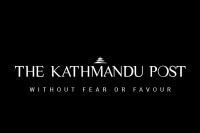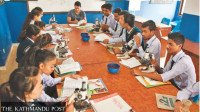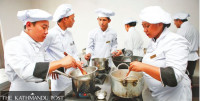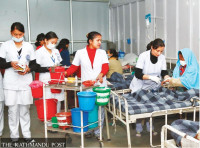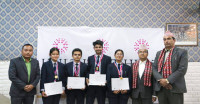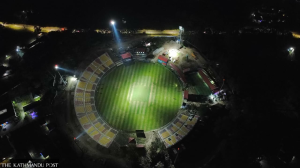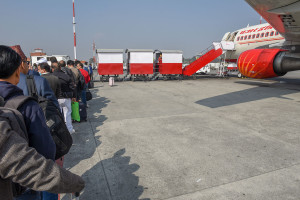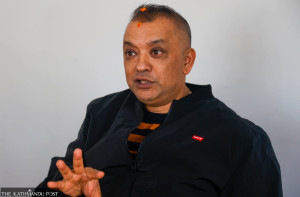Miscellaneous
A (seldom told) Bhutanese story
Resettled refugees may not feature in Bhutan’s oft-lauded happiness index, but the community is taking strides of their own in the US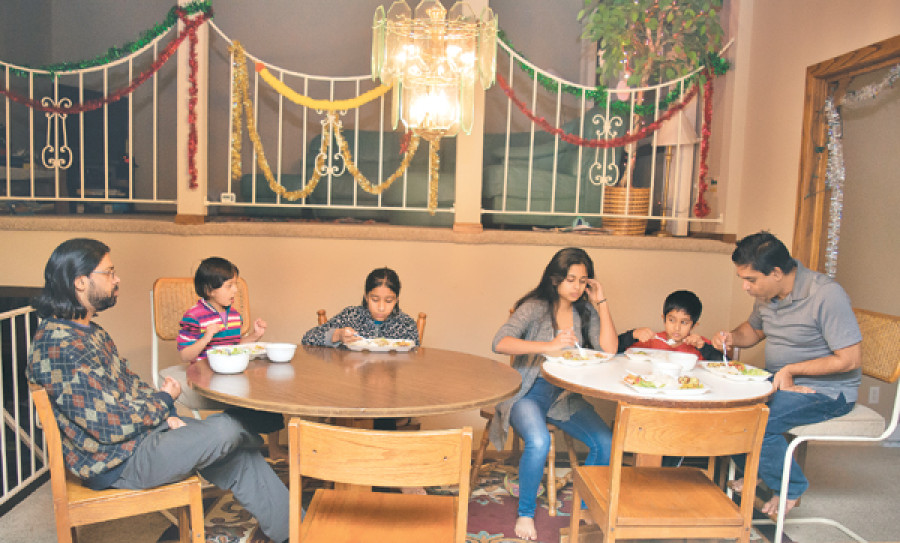
This year’s holiday season has arrived in the USA, and the neighbourhood of Shoreview, Minnesota, is lit up beautifully with colourful Christmas decorations. Six-year-old Prabhat coaxes his father relentlessly to put up decoration of their own out in the front yard. But his father, Parmananda Khatiwoda, who came to the US in 2008 with his family through the Bhutanese Refugee Resettlement Program, is not too keen. “It is not really our culture but we will never tell the kids ‘we don’t celebrate Christmas because we are not Christians’. So we used our Tihar lights as our Christmas decoration,” says Parmananda, who is also the chairperson of the Bhutanese Community Organization of Minnesota (BCOM). But Dashain and Tihar are everybody’s favourite festivals in his family, although celebrating them in America is not quite the same as celebrating them back ‘home’. The definition of home, however, varies greatly for the three distinct generations in this family.
At first glance, the Khatiwoda family does not seem much different from any other Nepali-speaking family settled in the suburbs of Minneapolis. But they have their own share of experiences that set them apart. After spending 18 years in the refugee camp Beldangi II, Parmananda left Nepal in October 2008 and arrived in Minnesota with his parents, wife and daughter. Later, in December of the same year, his brother’s family joined them as well. Since then, the family has grown to 10 members and has been living under the same roof, where they may have ultimately found a sense of belonging.
Khatiwoda was the fourth generation citizen in his ancestral lineage to be born in Bhutan. When the Bhutanese government started persecution in the early 90s of the Lhotshampas—people of Nepali roots who inhabited southern Bhutan—his family was among the thousands who left their homes and sought refuge in Nepal. “Life took a different course for us altogether. Our education and ambitions seemed futile when all you could do was to wait in queues for hours holding a sack, hoping to get some rations. For self-sustaining people like us, the experience was extremely humiliating,” says Parmananda. “We knew we would never be able to go back to Bhutan, so when the resettlement opportunity came along, we accepted it thinking it was the most viable solution.”
Seven years since their migration, despite the comfort of living in a cosy house in a peaceful neighbourhood, the elders of this family still call Bhutan their home. “Home is Bhutan, where we used to farm, raise cattle, and had huge orange orchards. Village life wasn’t easy, but we were happy”, reminisces the head of the family, Bhim Khatiwoda; his wife, Bheema, nods in approval. “It was depressing once we got to the camp in Nepal,” he adds, “for shelter we found a piece of plastic; we would eat if we were given food; we’re farmers but we had to hunt around for jobs, we were helpless refugees”, the sadness as he recollects his days in the refugee camp is still palpable.
Out of the camps, into the unknown
Since their resettlement, however, they are no longer going through such humiliations and their lives have taken a new trajectory. But adjusting to a new place always comes with its own set of challenges. Although the quality of life for many have improved vastly upon moving to the US, they are grappling on many fronts to adjust to the Western world. Bheema, the grandmother of four, says, “My husband and I don’t speak a word of English. Even the grandchildren, who otherwise talk with each other like Americans, communicate with us in Nepali. We are too old to learn a new language.” Language may not be a problem for this old couple inside their home, but they cannot ignore the inconvenience when they leave the house.
English language has been identified as a major cultural barrier among the elderly in this community. Their struggles with communicating with the outside world forces them to spend their days at home, leaving them susceptible to isolation and depression. Language barrier also causes complications in understanding the laws. The families that struggle with English are ultimately the ones who fall victims to deprivation of their own rights. There have been instances where important services like health care benefits and food stamps were lost because they could not read the mails that get delivered in English.
The younger generation, for whom language may not be a major issue, however, are frustrated for having to restart their lives all over again. “I feel that by now, I should have found a solid path in my career. I’m still pursuing my PhD. It seems as though schooling will never end for me,” says Parmananda. “It’s like pressing the reset buttons of our lives, when providing for our family should really be our priority,” he says.

A hybrid generation
Besides the outwardly seen struggles, something that is widely prevalent in these resettled families is the varied cultural identities among the different generations. “My parents say they are Bhutanese, I say I am a Nepali speaking Bhutanese American,” Parmananda says. The children, however, identify themselves as Nepalese American because they hear stories from their parents about the times they spent at refugee camps in Nepal.
“Yes, I am Nepali American and I like all festivals—Dashain, Tihar, Christmas for the gifts and New Year to watch the ball drop in New York,” exclaims 11-year-old Garima, who vaguely recalls her life in Nepal and takes pride in being multilingual. Upon request, she tussles a bit with Nepali numbers and with a slight American accent counts her ek, dui, teen all the way up to bees (twenty). Similarly, Prabhat takes pride in being his grandparents’ interpreter. There is a clear excitement in the younger generation, from 14-year-old Pratibha to four-year-old Mahima, who fervently share their enthusiasm upon the mention of either Bhaitika or Thanksgiving; the only pet peeve the elders have is the inefficient usage of Nepali at home and a slight concern that they may become too Americanised too soon.
Towards a dream
A similar yet different case of cross-generational, cross-cultural envoy, who is actively involved in making a difference in the lives of the refugees is Richa Sharma. This 24-year-old vibrant young woman was among the first few Bhutanese to land in Minnesota in 2003. Although Richa was only two-months-old when her family left Bhutan, she still calls Bhutan her home. She also has vivid memories of Birtamod, Jhapa where she grew up. “Mine is a slightly different story from the rest of the refugees,” says Sharma, “Despite being a refugee, I had a privileged life in Nepal, and had access to a good education. But we were refugees nonetheless.” Sharma strongly believes that education helped her family overcome the atrocities they faced and got them into the position to be able to help fellow Bhutanese. “My parents were able to use their education as a tool to be the voice for thousands of people in our community,” she adds.
After graduating from Carleton College in 2014, Sharma joined the American workforce as a Business System Analyst. But during her days at Carleton, she got a fellowship to do research on Bhutanese refugees. She shares her experience enthusiastically, “I interviewed a lot of politicians, social workers and media personnel, regarding why repatriation of Bhutanese was not possible. It was really frustrating trying to get all the answers but I learned a lot.” More recently, Sharma has been involved in the oral history project for the Hennepin History Museum where the stories of the Bhutanese refugee women are collected in their own voices and archived. Sharma is also active in community rebuilding efforts and youth empowerment through BCOM.
Suicide cases — a dire reality
Amongst all the fears and hopes, something that has shaken up this community for the last few years is the record-high number of suicide cases. What is more jarring is the fact that the incidents that spanned beyond a certain demographic group, across all genders and ages, and had no specific known reasons. According to a report published by the Center for Disease Control in 2012, the rate of suicide among the Bhutanese was 21.5 percent, whereas the global suicide rate was 16 percent.
Psychiatrist Dr Chhabi Sharma, a former Bhutanese refugee himself, is working closely with the Bhutanese community in and outside Minnesota to find answers and solutions to the issue. He believes the situation is the outcome of the treatment to Lhotshampas right from when they were in Bhutan. “Their struggles started in Bhutan where they were treated as second class citizens. They continued to be segregated and marginalised when they arrived in Nepal as refugees. And then there are more challenges in the US even after resettlement.” According to him, when people are stripped off their rights to practice their own culture and speak their own language, they seek some form of recognition for themselves. And when their struggles outlast their level of endurance, they become the victims of depression whether they are young or old, men or women, the culmination of which in most cases is suicide. This pattern is not only visible in the refugees in the US, but also those in the refugee camps in Nepal.
Although there has not been a suicide case among the Bhutanese in Minnesota, the community members are well aware of the epidemic. There is an ongoing effort in the Bhutanese community to identify and prevent such fatal outcomes. “There are various reasons that contribute towards one’s mental health condition and mixed marriage cases is one of them where the asylum is granted to the spouses if he or she is a refugee and not to the non-refugee spouse”, he says. “The copycat behaviour may also be a factor where other members of the community copy someone who killed themselves as a final means of escape”, he adds. As a psychiatrist, Sharma stresses that it is very important to work on an individual level to make people feel included, to hear them out, and most importantly, to make them understand that sharing their thoughts with a confidante, if not others, is vital.

The pioneers
In November 2015, UNHCR made an announcement that the Bhutanese Resettlement Program was “one of the most successful programmes of its kind” where more than 100,000 refugees from Bhutan were resettled in third countries. About 1,300 of those refugees were resettled in the upper midwestern state of Minnesota. Although Dr Sharma’s family did not resettle here through the programme, he and his wife, Mangala Sharma, have made some major contributions towards achieving that milestone.
The Sharma couple with their two daughters, were the first Bhutanese family to settle in Minnesota in 2003. It was only in 2008 that the resettlement programme opened doors for more Bhutanese to follow suit. With more refugees settling and more challenges to address, the couple started the BCOM that was later converted into a non-profit organisation. The organisation supports families right from their arrival in Minnesota to later stages when they have adjusted to the American lifestyle.
BCOM currently oversees a variety of projects including pairing local American host families with refugee families to help them from day one with every basic need and psychological support they may require. “The first three years is the most crucial period. From navigating the streets, to understanding the system well, it plays an important role in mitigating their initial hurdles,” says Mangala. Through their resettlement services they strive to provide cultural, financial, mental and elderly support to the refugees.
The ultimate aspiration
Despite myriad of setbacks, the Bhutanese community here in Minnesota is flourishing. “All we ought to do is fulfil our duties in the community and not stop raising awareness about our situation. Our stories may have gone unheard in the past but now there are channels through which many people know of our existence,” says Parmananda. The stories of the exiled Lhotshampas may be missing from Bhutan’s Happiness Index, but nearly all former refugees share the common passion of going back to Bhutan one day. For now though, they’re happily incorporating their own cultures into the customs and holidays of the place they have come to call home.
Text & Photos: Prapti Shrestha




 20.12°C Kathmandu
20.12°C Kathmandu
